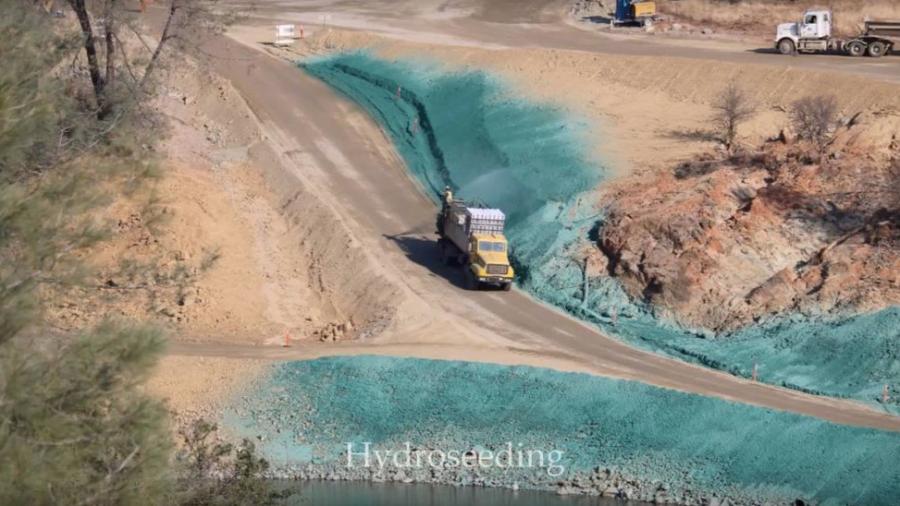Selby and his team worked through the night to repair the Oroville dam’s emergency spillway weir and ensure that any subsequent rains or spillage wouldn’t further erode the structure.
On Feb. 7, 2017, a 200-ft. pothole opened up in the main spillway of the Oroville Dam in northern California. With snowpack at 150 percent above normal in the Sierra mountains, and Lake Oroville still rising, officials reduced the amount of flow on the main spillway. On Feb. 12, as 188,000 residents downstream nervously watched on the news, water began tumbling over the never-before-used emergency spillway.
Water crested the 1,000-ft.-long emergency spillway and began carving a path down the dirt hillside, washing debris into the Feather River below. This created another dilemma. The dirt under the emergency barrier eroded faster than expected, and the integrity of the barrier was compromised. Officials evacuated residents downstream and increased the flow on the damaged main spillway.
The increased crater in the main spillway redirected the flow of water and created a separate channel to the right of the concrete structure, carving out even more dirt and debris. But it decreased the pressure just enough to allow officials to begin repairing the emergency spillway — a task that started in May of 2017 and is still ongoing.
With the clock ticking, and downstream residents waiting to return home, officials needed to repair the erosion and prevent further threat of collapse quickly and effectively. They just didn't have the right equipment.
Jay Selby, of Selby Soil Erosion Control, did. Selby answered the emergency call and began re-seeding the slopes of the emergency spillway that night with his fleet of Apex hydroseed applicators. Selby helped control erosion on the hillside and the critical ground beneath the emergency spillway barrier. When it came time to repair the concrete main spillway, Selby got another call, this time to help stabilize the haul roads and pads that cranes needed to access the job site.
Powerful Pumps
With a heavier than usual snowpack above stream and the threat of rain around the corner, Selby needed to reinforce the emergency spillway with a thick matrix, and quickly — without stopping for clogged pumps or refilling the trucks every hour. He used CocoFlex ET-FGM, a hydraulic application that gets its strength from a blend of coconut fibers.
Smaller hydroseeding units can't pump the thick pulp as well, but the Apex applicators sprayed it farther and faster, without clogging. Apex applicators use centrifugal pumps with a vortex impeller, which moves the mulch in a circular direction, so slurries circulate along the perimeter of the pump and have little to no contact with the impeller. This allows delicate seeds and nearly any viscosity of material to flow freely through the pump.
The extra pump pressure had an added effect of allowing Selby to spray off the tower of the hydroseed applicator and reach up to 300 ft. from the truck without using hoses. Hoses take time to bring in, set up, clean, and move. When an operator can spray from the truck tower, they save time and labor.
The vortex pump combined with minimizing twists and turns in the suction pipe allowed for discharge of nearly the entire tank of material without clogging, ensuring steady flow over long distances, greater efficiency and consistent, high-quality results.
"The CocoFlex is a lot more robust, and harder to pump — if you had a small pump machine it probably wouldn't do very well with that product," Selby said.
High Capacity Tanks
Selby's operators put down CocoFlex at 4,500 lbs. per acre along with a native seed mix and fertilizer. Selby brought two 4,000-gal. Apex tanks on the 100-acre job site. A hydroseed applicator would fill up, spray an acre and let it cure while refilling then spray it again, a total of four coats. It's a rigorous and demanding process that wouldn't be possible on a smaller tank, but Selby's Apex hydroseed applicators had no problem with it.
On difficult to reach job sites, refilling hydroseeding tanks can cost valuable time. Apex hydroseed applicators are designed wider and shorter than other applicators to maximize tank capacity, allowing Selby to stay on the job and spraying longer than he ever could before. Comparable hydroseeding models are up to 4 ft. longer, extending the wheel base and decreasing maneuverability on the job site.
Getting the job done on hard to reach jobs like the Oroville dam means maximizing equipment with the fewest stops possible to reload the tank.
Rebuilding, Repair
In May, Selby Soil Erosion Control returned to the Oroville Dam to help repair the damaged main spillway. The dam has its own quarries, concrete plants and rock crushing areas that provide construction material onsite. The repair project included creating haul roads to move material and creating level areas for the concrete plants and rock crushing plants. There also were dozens of crane pads created to access the job site up and down the spillway — each of which required cutting slopes above and below, exposing even more bare soil.
Those roads and pads involved constant grading and disturbing massive amounts of dirt — Selby's job was to make sure that dirt stayed put. Creating a zig zag of haul roads over the steep site involved cutting slopes to stabilize the roads. Selby sprayed those slopes to keep the roads in place so the unprecedented amount of heavy equipment could access the various points of the job site.
Selby and his team worked through the night to repair the Oroville dam's emergency spillway weir and ensure that any subsequent rains or spillage wouldn't further erode the structure. Selby Soil and Erosion Control has even been brought back to provide erosion control when teams began to repair damage to the site. Residents downstream of the Oroville Dam can rest easy, knowing Selby Soil Erosion Control, armed with Apex hydroseed applicators will ensure that erosion at the Oroville dam is under control.
Today's top stories















